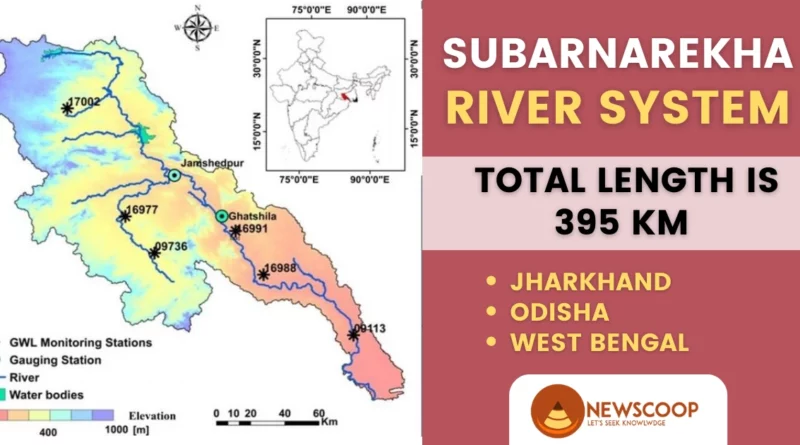Subarnarekha River: Tributaries | Map & Dams
Subarnarekha River is a transboundary river that flows through the Indian states of Jharkhand, West Bengal, and Odisha, and also through the country of Bangladesh. It is a major river in the region, and its name means “Golden Line” in Bengali. The river has significant historical and cultural significance, and it plays an important role in the lives of the people who live in the region.
In this article, we will explore the various aspects of the Subarnarekha River, including its geography, history, cultural significance, dams, tributaries, and ecological importance.
| Property | Description |
|---|---|
| River | Subarnarekha |
| Length | 395 km (245 mi) |
| Source | Chota Nagpur Plateau in Jharkhand |
| Mouth | Bay of Bengal |
| Basin | 37,062 km² |
| Tributaries | Kharkai River, Damodar River, Dulung River |
| Major Cities | Jamshedpur, Ranchi, Balasore |
| Dams | Galudih Dam, Chandil Dam, Subarnarekha Dam |
| Major Bridges | Subarnarekha Bridge, Chandil Dam Bridge |
| Important Uses | Irrigation, Hydroelectric power generation |
| Threats | Deforestation, Mining, Industrial Pollution |
Features of Subarnarekha River
Here are some important facts about the Subarnarekha River in bullet points:
- The Subarnarekha River is a major river in eastern India that flows through the states of Jharkhand, Odisha, and West Bengal.
- The name “Subarnarekha” means “golden streak” in the local language, and it is believed that the river got its name from the golden sand particles found in its bed.
- The river originates in the Chhotanagpur plateau in Jharkhand and flows for a total length of about 395 kilometers before joining the Bay of Bengal.
- The Subarnarekha River has several tributaries on both its left and right sides, including the Kharkai, Sankh, and Dulung Rivers on the left side, and the Damra, Kanchi, and Brahmani Rivers on the right side.
- The river is an important source of water for irrigation and drinking purposes for the people living in the region.
- The Subarnarekha River basin has significant mineral deposits, including iron, copper, and gold, which have been mined for centuries.
- The river is home to several species of aquatic animals, including the endangered Gangetic dolphin, and supports a rich diversity of flora and fauna in its surrounding forests and wetlands.
- The Subarnarekha River has been the site of several major floods in the past, including the devastating floods in 2008 that caused widespread damage to crops and property in the region.
- There are several dams built on the Subarnarekha River and its tributaries, including the Chandil Dam, Galudih Barrage, and the Subarnarekha Multipurpose Project, which serve various purposes such as hydroelectric power generation, irrigation, and flood control.
- The river and its surrounding areas are culturally rich, with several ancient temples and historical sites located along its banks, including the famous Jagannath Temple in Balasore.
Origin of Subarnarekha River
The Subarnarekha River originates from the Chota Nagpur Plateau in Jharkhand, India. The exact location of the origin is Piska Nagri, which is located in the Ranchi district of Jharkhand.
States through which the Subarnarekha River Flows
The Subarnarekha River flows through the following states:
- Jharkhand
- West Bengal
- Odisha
Dams on Subarnarekha River for UPSC
There are several dams built on the Subarnarekha River and its tributaries, which serve various purposes such as hydroelectric power generation, irrigation, and flood control.
Following are some of the major dams on the Subarnarekha River:
- Galudih Dam
- Galudi Dam
- Subarnarekha Dam
- Mandira Dam
- Rengali Dam
1. Chandil Dam
- The Chandil Dam is located on the Subarnarekha River in Jharkhand, near Chandil town.
- It was built in 1957 for the purpose of irrigation and flood control.
- The dam has a height of 220 feet and a capacity of 20,040,000 cubic meters.
2. Galudih Barrage
- The Galudih Barrage is located in Jharkhand, near Galudih.
- It was built in 1953 for the purpose of irrigation and flood control.
- The barrage has a length of 1,780 feet and a height of 23 feet.
3. Subarnarekha Multipurpose Project
- The Subarnarekha Multipurpose Project is located on the Subarnarekha River near Jamshedpur in Jharkhand.
- It was built in 1996 for the purpose of hydroelectric power generation, irrigation, and flood control.
- The project consists of a dam, a power station, and a canal system.
- The dam has a height of 51 meters and a capacity of 8.88 billion cubic meters.
4. Mandira Dam
- The Mandira Dam is located on the Sankh River, which is a left tributary of the Subarnarekha River.
- It is located in Odisha, near the border with Jharkhand. The dam was built in 1958 for the purpose of irrigation and flood control.
- The dam has a height of 41 meters and a capacity of 26.58 million cubic meters.
5. Rengali Dam
- The Rengali Dam is located on the Brahmani River, which is the right tributary of the Subarnarekha River.
- It is located in Odisha, near the border with Jharkhand.
- The dam was built in 1985 for the purpose of hydroelectric power generation, irrigation, and flood control.
- Further, the dam has a height of 65 meters and a capacity of 3.6 billion cubic meters.
These dams have helped to improve the socio-economic condition of the region by providing irrigation water for agriculture, generating hydroelectric power, and reducing the damage caused by floods. However, their construction and operation have also caused some negative environmental impacts such as the displacement of local communities and the alteration of the natural flow of the river.
Map of Subarnarekha River

Tributaries of the Subarnarekha River
The following are the major tributaries of the Subarnarekha River:
- Kharkai River
- Sankh River
- Dulung River
- Damra River
- Kanchi River
- Brahmani River
Left Bank Tributaries
- Kharkai River – It is one of the major tributaries of the Subarnarekha River and originates in Jharkhand.
- Sankh River – It is a seasonal river that originates in the hills of Jharkhand.
- Dulung River – It is a small river that originates in the Simlipal hills of Odisha.
Right Bank Tributaries
- Damra River – It originates in the Simlipal hills of Odisha and joins the Subarnarekha River near Rasgovindpur.
- Kanchi River – It is a major tributary of the Subarnarekha River and originates in the Chhotanagpur plateau in Jharkhand.
- Brahmani River – It is a large river that originates in the Kendujhar district of Odisha and joins the Subarnarekha River near Rajghat.
These tributaries not only add to the water volume of the Subarnarekha River but also contribute to the ecological diversity of the region. They also play an important role in supporting the livelihoods of the people who live along their banks by providing water for irrigation and fishing.
History & Cultural Significance
The Subarnarekha River has significant historical and cultural importance in the region. It has been mentioned in several ancient texts, including the Ramayana and the Mahabharata. The river was also an important trade route in ancient times, and it played a vital role in the economic development of the region.
The region surrounding the River is also home to several indigenous tribes, including the Santhals, Ho, and Munda tribes. These tribes have a rich cultural heritage and have lived in the region for centuries. The river is an important part of their cultural and spiritual traditions, and it is considered sacred by many of them.
Why Subarnarekha River is Ecological Importance?
The Subarnarekha River is an important source of water for the people who live in the region, and it supports a rich and diverse ecosystem. The river and its tributaries are home to several species of fish, including the hilsa and rohu, which are important for the local economy.
The river and its surrounding forests are also home to several species of wildlife, including elephants, tigers, and leopards. The region is also a habitat for several species of birds, including the Indian pitta and the Asian paradise flycatcher.
However, the Subarnarekha River is facing several environmental challenges, including pollution and habitat destruction. Industrial effluents and agricultural runoff have polluted the river, and deforestation has led to soil erosion and loss of habitat for wildlife.
Efforts are being made to address these challenges and restore the health of the river and its surrounding ecosystem. The government has implemented several initiatives to reduce pollution and promote sustainable development in the region. Several non-governmental organizations are also working to raise awareness about the importance of the river and its ecosystem and promote conservation efforts.
Conclusion
The Subarnarekha River is an important and culturally significant river in the region. It has played a vital role in the economic, cultural, and spiritual development of the people who live in the region. However, it is facing several environmental challenges, and efforts must be made to address these challenges and restore the health of the river and its surrounding ecosystem.
By working together, we can ensure that the Subarnarekha River remains an important and vibrant part of the region’s heritage for generations to come.
Thank You!
What is the length of the Subarnarekha River?
Subarnarekha River has a total length of approximately 395 kilometers, starting from its origin in the Chota Nagpur Plateau in Jharkhand to its mouth at the Bay of Bengal.
Where does the Subarnarekha River originate from?
The Subarnarekha River originates from the Chota Nagpur Plateau in Jharkhand, India. The river is formed by the confluence of two smaller rivers, namely, Kharkai and Raru, near Ranchi, the capital city of Jharkhand.
What are some of the major dams built on the Subarnarekha River?
Some of the major dams built on the Subarnarekha River include Galudih Dam, Chandil Dam, Subarnarekha Dam, Bankabal Dam, Panchet Dam, and Maithon Dam.
Subarnarekha River is a tributary of which river?
The Subarnarekha River is a major river in the Indian states of Jharkhand, West Bengal, and Odisha. It is primarily a river in its own right and does not serve as a tributary to any other river.
Subarnarekha River originates from which state?
The Subarnarekha River originates from the state of Jharkhand in India. It emerges from the Chota Nagpur Plateau near the Ranchi district in Jharkhand.
Subarnarekha River enters Odisha in which district?
The Subarnarekha River enters Odisha in the Mayurbhanj district.
Related Links:

